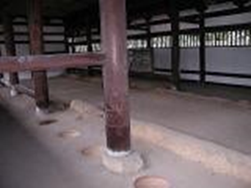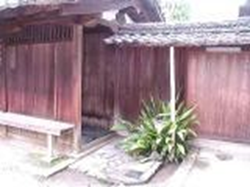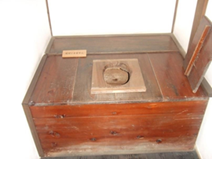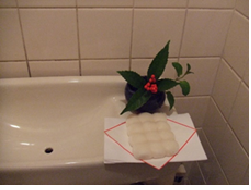The origins of high heels and bunions II Important cultural property toilets and Japan’s hidden history
Yoshie Doi
 Tofukuji Temple’s Toushu (Important Cultural Property) |
 Ikkyu-ji Temple’s Toushu (Important Cultural Property) |
 Japan’s oldest Western-style toilet: Niijima Residence (Kyoto City) |
 Approximately 2,700 temporary toilets (Kobe City) immediately after the Great Hanshin Earthquake |
 New Year’s toilet kagami mochi twelve mochi 12th mochi for 12 months of care Photo taken on January 1, 2012 |
When Kyo-Suzume was first established, we did a fieldwork called “Visiting Kyoto’s Treasured Toilets.” We visited toilets designated as Important Cultural Properties, and conducted fieldwork on Western-style toilets with tatami mats, the oldest Western-style toilet in Japan, and other toilets. We have held such fieldwork many times.
At that time, I was with an interesting group of people, including a university president, an artist, and a toilet painting artist. Historical toilets can be enjoyed not only for inspection, but also as cultural tourism. In particular, the relationship between eating and excretion is inseparable, and is related to human existence.
About 20 years ago, we could actually use the toilet at Ikkyu-ji Temple, but now we can only look around. I remember having fun wandering around and checking out the Western-style toilets with tatami mats and the painted toilets of the Imperial Palace restaurant.
As mentioned earlier, European high heels originated as a way to keep out feces and urine. In medieval Paris, people had the habit of urinating on the streets, so boots were the best way to walk on roads filled with filth, and shoes with thick soles to keep out filth became popular, which became the origin of high heels. Humans think the same way, and high clogs also originated as a way to keep out feces. Incidentally, it is said that the palace was moved from Paris to Versailles because the city was unclean.
In Japan, towns were clean and waste was recycled back into the fields, a custom that continued into the Showa era. Toilets are thought to have become widespread in Japan during the Kamakura period, and as agricultural production increased by using manure as fertilizer, an ecosystem was created in which the waste was naturally recycled back into the fields. Manure had to be stored before being returned to the fields, and during the Muromachi period it was traded for money, and obtaining it was a matter of life and death for farmers.
It is said that the beginning of public toilets was in 1603, when Okuni, the creator of Kabuki, performed her first Kabuki dance at Kitano Shrine (Kitano Tenmangu Shrine), and a public toilet was constructed by stretching a cloth around the Ukon no Baba area of the shrine grounds. The area around Kitano Shrine was used as a public square for entertainment such as Sarugaku and Kumabu, and was bustling with pilgrims from high and low.
In the Meiji era, riding the wave of the Freedom and People’s Rights Movement, newspapers became popular among the general public, and as a result, newspapers cut into small pieces were used as the original toilet paper. It began to be used as a dropper. Considering that leaves and Phragmites australis(Yoshi)had been used up until that point, the “civilization and enlightenment of toilets” truly began with the Meiji Restoration. The relationship between social issues and toilets is intimate.
Recently, the toilet issue at the Osaka Expo brought to light Japan’s good and noble sense of toilets in an unexpected place. It is also interesting to look at history while picking up perspectives that have been buried in history.
The end of document
Translated by Masami Otani
